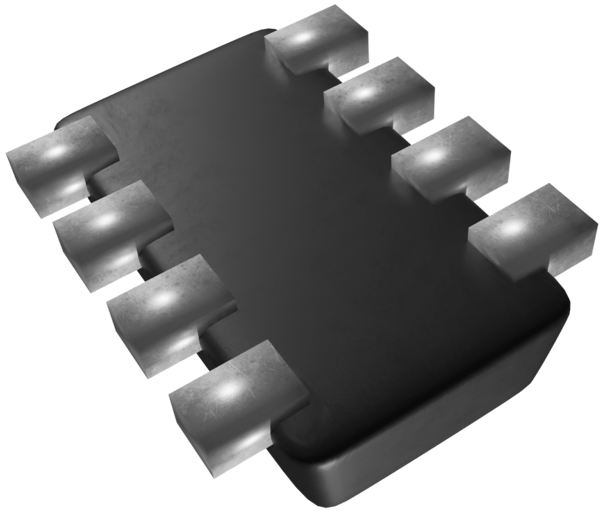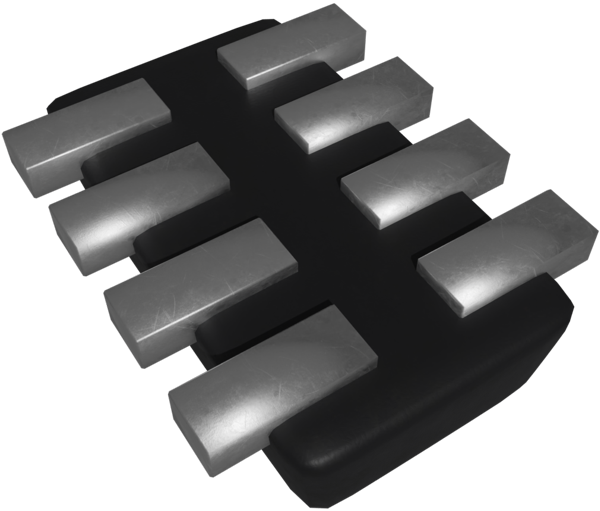SLVAFM5 September 2023 TPS628501-Q1 , TPS628502-Q1 , TPS629210-Q1 , TPS629211-Q1
Introduction
When making system design decisions, selecting the right package for a device can critically influence the reliability and performance of the end system. In some applications, package type and characteristics are a key consideration. Some factors to keep in mind are size, pinout, and thermal and electrical performance.
Modern automotive, industrial, and enterprise power trees are powering more devices than ever. To keep up with expanding power trees, battery-operated systems rely on efficient, low-leakage converters to maintain battery charge and health when connected to many points of load. To further enable more efficient production and thermal capabilities of automotive and industrial systems, the extended leads SOT-5X3 DYC package have been adopted to some Texas Instruments automotive power products.
 Figure 1 Example of a SOT-583 DRL
Package
Figure 1 Example of a SOT-583 DRL
Package Figure 2 Example of SOT-583 DYC
Package
Figure 2 Example of SOT-583 DYC
PackageApplication
Reliability across multiple points of load is a key concern for OEMs. Optical and X-ray inspections are used to validate SMT device solder joint cohesion and alignment. Due to the costliness of X-ray inspection technology, optical inspections are preferred by some automotive OEMs. The DYC package provides visual clarity to the state of the solder bridging of a device to a solder pad on a PCB.
 Figure 3 Cross-Section Illustration of
Solder Distribution on DRL and DYC Packages
Figure 3 Cross-Section Illustration of
Solder Distribution on DRL and DYC PackagesSince the pin leads of the DRL package are the same length of the pad, there is greater difficultly in verifying if the solder joint between the lead and the PCB pad has a valid, reliable connection. For many SOT-5X3 packages, this cannot be determined on optical and X-ray inspection alone and as a result, electrical testing is required. However, electrical testing can incur greater testing and manufacturing costs. The DYC package features extended pin leads that are physically longer than the pad without changing the footprint of the package. The leads of the DYC package can be optically and X-ray inspected for solder connection integrity, which can increase the speed of validation and quality-compliance. All designs that undergo optical and X-ray testing can benefit from higher efficiency inspection workflow of the DYC package.
Managing thermal dissipation is a key requirement for these systems. The wide range of thermal loads for these devices require for high thermal conductivity away from the converter. A benefit of the DYC package is increased thermal efficiency due to the increased surface area to the lead frame. Designs targeted for high-ambient temperature environments, such as automotive powertrain or zonal architecture modules, can benefit from higher thermal efficiency.
| Part Number | TPS628501-Q1 | TPS628502-Q1 | TPS629211-Q1 | TPS629210-Q1 |
|---|---|---|---|---|
| Input Voltage | 2.7–6 V | 2.7–6 V | 3–10 V | 3–17 V |
| Output Voltage | 0.6–5.5 V | 0.6–5.5 V | 0.4–5.5 V | 0.4–5.5 V |
| Output Current | 1 A | 2 A | 1 A | 1 A |
| Quiescent Current (typ) | 0.017 mA | 0.017 mA | 0.004 mA | 0.004 mA |
References
- Texas Instruments, Using the TPS629210-Q1 in an Inverting Buck – Boost Topology, application note.
- Texas Instruments, Improving Efficiency at Higher Loads with High Switching Frequencies, application note.
- Texas Instruments, Power-Supply Design for Horizon Robotics Journey 3 ADAS SoC, application brief.
- Texas Instruments, Synchronizing DC/DC Converters in a Power Tree, application note.